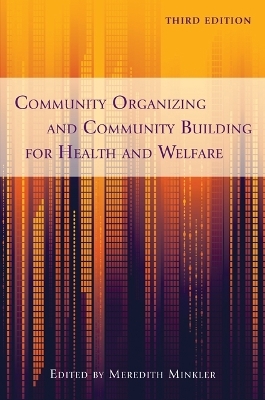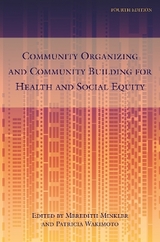
Community Organizing and Community Building for Health and Welfare
Rutgers University Press (Verlag)
978-0-8135-5300-9 (ISBN)
- Titel erscheint in neuer Auflage
- Artikel merken
The third edition of Community Organizing and Community Building for Health and Welfare provides new and more established ways to approach community building and organizing, from collaborating with communities on assessment and issue selection to using the power of coalition building, media advocacy, and social media to enhance the effectiveness of such work.
With a strong emphasis on cultural relevance and humility, this collection offers a wealth of case studies in areas ranging from childhood obesity to immigrant worker rights to health care reform. A "tool kit" of appendixes includes guidelines for assessing coalition effectiveness, exercises for critical reflection on our own power and privilege, and training tools such as "policy bingo." From former organizer and now President Barack Obama to academics and professionals in the fields of public health, social work, urban planning, and community psychology, the book offers a comprehensive vision and on-the-ground examples of the many ways community building and organizing can help us address some of the most intractable health and social problems of our times.
Dr. Minkler's course syllabus: Although Dr. Minkler has changed the order of some chapters in the syllabus to accommodate guest speakers and help students prep for the midterm assignment she uses, she arranged the actual book layout in a way that should flow quite naturally if instructors wish to use it in the order in which chapters appear.
MEREDITH MINKLER, DrPH, MPH, is a professor of health and behavior at the School of Public Health, University of California, Berkeley, and the founding director of the university’s Center on Aging. She is the coauthor or editor of numerous books, including Community-Based Participatory Research: From Processes to Outcomes (with Nina Wallerstein).
List of Illustrations
Acknowledgments
PART ONE
Introduction
1. Introduction to Community Organizing and Community Building
2. Why Organize? Problems and Promise in the Inner City
PART TWO
Contextual Frameworks and Approaches
3. Improving Health through Community Organization and Community Building
4. Contrasting Organizing Approaches
5. Community Building Practice
PART THREE
Building Effective Partnerships and Anticipating and Addressing Ethical Challenges
6. Community, Community Development, and the Forming of Authentic Partnerships
7. Ethical Issues in Community Organizing and Capacity Building
8. Building Partnerships between Local Health Departments and Communities
PART FOUR
Community Assessment and Issue Selection
9. Community Health Assessment or Healthy Community Assessment
10. Mapping Community Capacity
11. Selecting and “Cutting” the Issue
PART FIVE
Community Organizing and Community Building within and across Diverse Groups and Cultures
12. Education, Participation, and Capacity Building in Community Organizing with Women of Color
13. African American Barbershops and Beauty Salons
14. Popular Education, Participatory Research, and Community Organizing with Immigrant Restaurant Workers in San Francisco’s Chinatown
PART SIX
Using the Arts and the Internet as Tools for Community Organizing and Community Building
15. Creating an Online Strategy to Enhance Effective Community Building and Organizing
16. Using the Arts and New Media in Community Organizing and Community Building
PART SEVEN
Building, Maintaining, and Evaluating Effective Coalitions and Community Organizing Efforts
17. A Coalition Model for Community Action
18. Community Organizing for Obesity Prevention in Humboldt Park, Chicago
19. Participatory Approaches to Evaluating Community Organizing and Coalition Building
PART EIGHT
Influencing Policy through Community Organizing and Media Advocacy
20. Using Community Organizing and Community Building to Influence Public Policy
21. Organizing for Health Care Reform
22. Media Advocacy
Appendixes
1. Principles of Community Building
2. Action-Oriented Community Diagnosis Procedure
3. Challenging Ourselves
4. A Ladder of Community Participation in Public Health
5. Coalition Member Assessment
6. Community Mapping and Digital Technology
7. Using Force Field and “SWOT” Analysis as Strategic Tools in Community Organizing
8. A Checklist for Action
9. Criteria for Creating Triggers or Codes for Freirian Organizing
10. Scale for Measuring Perceptions of Control at the Individual, Organizational, Neighborhood, and beyond-the-Neighborhood Levels
11. Policy Bingo
About the Contributors
Index
| Zusatzinfo | 18 figures and tables |
|---|---|
| Verlagsort | New Brunswick NJ |
| Sprache | englisch |
| Maße | 156 x 235 mm |
| Gewicht | 853 g |
| Themenwelt | Medizin / Pharmazie ► Gesundheitswesen |
| Studium ► Querschnittsbereiche ► Prävention / Gesundheitsförderung | |
| ISBN-10 | 0-8135-5300-8 / 0813553008 |
| ISBN-13 | 978-0-8135-5300-9 / 9780813553009 |
| Zustand | Neuware |
| Informationen gemäß Produktsicherheitsverordnung (GPSR) | |
| Haben Sie eine Frage zum Produkt? |
aus dem Bereich



